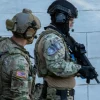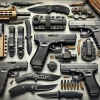Special operations units are renowned for their ability to handle high-risk missions with exceptional precision and efficiency. These elite teams operate in a wide variety of environments, often facing unpredictable challenges. To meet these demands, they require a diverse set of skills, tactics, and, importantly, versatile weaponry. The adaptability and effectiveness of their weapons can greatly influence mission success. This article delves into the essential role that versatile weapons play in modern special operations, exploring various firearms and tools that enable these forces to excel under extreme conditions.
The Necessity of Versatile Firearms
In the ever-changing scenarios that special operations units face, having versatile firearms is crucial. These weapons must be reliable and adaptable to different situations, performing well in urban warfare, dense forests, and arid deserts alike. Special operations personnel need firearms that can be easily customized with attachments like scopes, suppressors and grips to fit specific mission needs.
Take, for example, the Smith & Wesson Lever Action Rifle. This rifle offers remarkable accuracy and reliability, making it suitable for both long-range engagements and close-quarters combat. Its lever-action mechanism allows for quick reloading, a critical feature in high-stress situations.
Adaptability in Tactical Scenarios
Versatile weapons allow special operations forces to adapt quickly to changing tactical situations. Whether they are engaged in direct combat, providing support fire, or conducting covert operations, the ability to switch between different modes and attachments is essential. For instance, firearms like the AR-15 can be equipped with a variety of optics, barrel lengths, and suppressors, enabling operators to modify their weapons based on mission requirements.
Another prime example of versatile weaponry is the iconic M4 Carbine, often equipped with a full metal jacket ammunition for enhanced penetration and stopping power. The use of FMJ rounds ensures that the M4 can perform effectively against various targets, providing the necessary lethality in diverse combat scenarios. This flexibility makes it a preferred choice for special operations units, allowing them to maintain the upper hand in both offensive and defensive operations.
Additionally, firearms such as the 12 Gauge Shotgun Pistol offer unique capabilities for special operations. This type of weapon is ideal for breaching doors and close-quarters combat, where its stopping power and compact size are invaluable. The ability to carry and use such diverse weaponry ensures that special operations units can respond effectively to a wide range of threats.
The Impact of Modern Technology
Advancements in weapon technology have significantly enhanced the capabilities of special operations forces. Modern firearms are engineered with precision, using lightweight materials and ergonomic designs that improve handling and accuracy. Innovations like modular weapon systems allow operators to quickly change configurations, adapting their firearms to different combat scenarios without needing to carry multiple weapons.
For example, modular rifles like the FN SCAR (Special Operations Forces Combat Assault Rifle) can be configured with different barrel lengths and calibers, making them suitable for a variety of missions. These rifles are built to operate reliably in harsh conditions, providing special operations personnel with a dependable tool that can be tailored to their needs. Learn more about the advancements in special operations forces.
The integration of advanced optics and targeting systems is another technological advancement that has revolutionized special operations. Modern scopes and sights offer enhanced accuracy, night vision capabilities, and thermal imaging, which are invaluable in low-light and nocturnal operations. These technologies enable operators to identify and engage targets with greater precision, significantly increasing their effectiveness in the field.
Enhancing Operator Efficiency
Versatile weaponry not only boosts the tactical effectiveness of special operations units but also improves the efficiency of individual operators. Weapons that are easy to handle, maintain, and customize allow operators to focus more on their mission objectives and less on their equipment. The ability to quickly adapt a firearm to different roles—such as switching from a sniper configuration to an assault rifle setup—enables operators to perform multiple functions without carrying excessive gear.
Furthermore, personal defense weapons (PDWs) and sidearms are critical components of a special operator’s arsenal. These compact and powerful weapons provide a reliable backup option in situations where primary firearms may be impractical or unavailable. The integration of advanced optics and targeting systems further enhances these weapons’ effectiveness, allowing for rapid target acquisition and increased accuracy.
For example, the Heckler & Koch MP7, a widely used PDW, is valued for its compact size and high rate of fire. It can be equipped with various optics and suppressors, making it highly adaptable for different mission requirements. Such versatility ensures that operators can respond effectively to unexpected threats.
The Role of Training and Proficiency
While the versatility of weaponry is paramount, the proficiency of the operators using these weapons is equally important. Special operations forces undergo rigorous training to master their equipment, ensuring they can operate effectively under the most challenging conditions. This training includes weapons handling, marksmanship, and tactical drills that simulate real-world scenarios.
In addition to physical training, special operations personnel also benefit from continuous education on the latest advancements in weapon technology. This knowledge helps them stay ahead of potential adversaries and maintain a technological edge. Regular training and practice ensure that operators can seamlessly integrate new weapons and technologies into their arsenal, maximizing their effectiveness on the battlefield.
Moreover, special operations units often engage in joint exercises with other military and law enforcement agencies. These collaborative training sessions enhance interoperability and allow operators to share best practices and strategies. Such cross-training is crucial for missions that require coordination between different units and agencies.
Supporting Equipment and Accessories
Beyond firearms, special operations units rely on a wide range of supporting equipment and accessories to enhance their operational capabilities. This includes items such as tactical vests, night vision goggles, and communication devices. Each piece of equipment plays a vital role in ensuring mission success, providing critical support in various operational scenarios.
For personal defense and non-lethal options, operators often carry tools like defensive keychains. These compact and effective tools provide an additional layer of protection in close-quarters situations. You can find a large selection of fashionable defensive keychains here.
Tactical vests, for instance, are essential for carrying ammunition, medical supplies, and other mission-critical gear. Modern vests are designed with modular systems that allow operators to customize their loadout based on the mission’s requirements. This modularity enhances both comfort and functionality, enabling operators to move swiftly and efficiently.
Communication devices are equally crucial, ensuring that team members can coordinate their actions and share real-time intelligence. Advanced radio systems and encrypted communication channels provide secure and reliable links, which are vital for the success of covert and high-risk operations.
The importance of versatile weaponry in special operations cannot be overstated. These elite forces rely on a wide range of firearms and tools to adapt to the diverse and unpredictable environments they operate in. From the adaptability of modular rifles to the specialized capabilities of breaching shotguns, the versatility of their weaponry enhances their ability to perform complex and high-risk missions. Combined with rigorous training and advanced technology, versatile weaponry ensures that special operations units remain at the forefront of tactical excellence, ready to face any challenge that comes their way.
The success of special operations units hinges on their ability to adapt to rapidly changing situations. Versatile weaponry, supported by advanced technology and rigorous training, provides these elite forces with the tools they need to achieve their objectives. As threats continue to evolve, the need for adaptable and reliable weaponry will remain a cornerstone of special operations strategy, ensuring that these units can continue to operate effectively in any environment.





